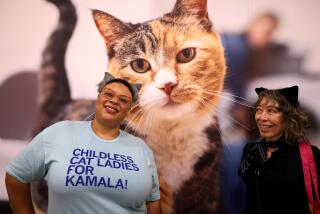Cat Cloning Really Sets the Fur Flying
- Share via
The birth of cloned kitten CC shows once again that some scientists spend far too much time in their laboratories and out of the grip of reality (“In Texas, Cloning Advance Comes on Little Cat Feat,” Feb. 15). If Drs. Tae Young and Mark Westhusin had visited any shelter in any community in this country they would have found thousands of wonderful kittens on just the day little CC was born.
As much as we love the animal companions who share our home, we would never consider cloning any of them. There are far too many homeless animals out there literally dying for lack of a home. Also, their life histories are part of the wonder of our dog, cats, rabbits and guinea pig. If our kitten Harley hadn’t been rescued from small boys about to throw him into traffic at the age of 2 weeks, he wouldn’t be the funny little guy he is, craving food, warmth and touch and being cautious with strangers.
Here’s a plan: If we’re going to clone anything, let’s clone humans with a modicum of compassion and common sense.
Diane Calkins
Encinitas
*
I have owned animals continuously for the last 45 years and am, in many ways, a person who might be termed an extremist when it comes to this subject. My pets have always lived in the house, slept on my bed and have been given expensive and extensive medical care, even in advanced old age. In fact, I prepare their food myself because I firmly believe that no commercially prepared animal food is completely acceptable. However, I have never even vaguely considered cloning one of them.
Cloning enthusiasts, at least among animal owners, fail to recognize that it is nothing more than scientific sleight of hand. It is not immortality but merely a replacement pet that looks suspiciously like the deceased one and will allow the owner to indulge a strange fantasy--not unlike that presented in stories such as William Faulkner’s “A Rose for Emily.” Grieving pet owners need to turn to reputable breeders or humane organizations for new sources of animal companions rather than to the medical laboratory.
Maria Werner
La Verne


